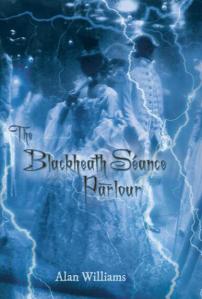
The Blackheath Seance Parlour is a new novel by Alan Williams, published tomorrow. I was lucky enough to receive an advance copy, which I’ve just finished reading. Below are some thoughts on it.
We are placed in the 1840s and into the lives of two sisters who are running a chocolate shop in Blackheath. The business is going very badly, and so they decide to open a seance parlour instead.
To say that the novel is set in Blackheath is an understatement. Almost every important scene takes place in the village. All the pubs, churches, and other key buildings in Greenwich, Lewisham and Lee appear throughout the novel. But what really makes it interesting is the way in which the author has woven the fictional characters around real historical figures from the area. I found myself rushing over to Wikipedia several times, to try and decide whether the new guest at a dinner party really was the “father of meteorology” or not (he was), or whether the architect really did build All Saints church (he did).
Although set in the 1840s, the dialogue between the characters feels fresh and alive. It’s a funny blend of genres – at times it felt as though I was reading Cranford, at other times gothic novels such as Vathek sprang to mind. The level of consternation within the village at changes to the high street felt as though they had stepped from the comments pages of this blog at times!
Page 63:
“A new shop in the village was big news. A suitable addition could uplift everyone and give their lives renewed inspiration and purpose, whereas the wrong shop could lead to depression and a sense that the village was sliding into ruin. On the rare occasions that this occurred, the owners were ostracised, there was an unspoken boycott and soon, through ruin or social pressure, the shop was gone and everyone was happy again. Blackheath was a very fussy village.”
I particularly enjoyed the proprietress of the Blackheath Tea Hut. Whether it really existed before the 1920s isn’t clear but it’s great fun either way. As she explains:
‘They are trying to close us down again. It’s always the same people. They said because we are a wooden building and every so many decades we need to rebuild, that each time we should apply as if we are a brand new business. It is so they can say no to us. This is, and always has been, our part of the heath. But every time they refuse to acknowledge the previous hut so they shorten our history. Well we’ve built it strong this time. This hut will be here well into the 1920s. Let them stick that in their pipes.They say that we attract the wrong sort but everyone knows it is because we draw the crowds that refuse to pay the scandalous prices of the tea room in the park.’
It doesn’t matter that there is some artistic license. I don’t mind whether Princess Sophia really used to look up into the sky from the Ranger’s House with her telescope – it’s still a lovely image.
We’re in a world where spiritualism is real. Although there are many charlatans, some people really can contact the afterlife, and this is key to the plot. The church takes a dim view of this, and many of the arguments in the book (mostly after several glasses of strong port or oily gin at the Hare and Billet) are between the main characters and the local vicar. Even if you find fortune-tellers and mysticism irritating in the real world, you are gradually sucked into the excitement and mystery of the story, and probably end up siding with them before the book has finished with you.
This is a book containing a novel within a novel, and the internal novel is a little tiresome for the first few pages, perhaps because it is written in such a hyper-gothic penny-dreadful style (even though this is historically accurate). But I soon found myself caught up in the adventures of the mysterious count, with glimmers of The Count of Monte Cristo.
One of the most discouraging things I read about the book before actually attempting it was that this was a vampire novel. It isn’t. If you are sick of the sight of True Blood, if Twilight has you reaching for the sick bag, do not be dissuaded from reading this book! It doesn’t have any of the vampires-as-metaphors-for-chastity and it’s much more like “Cranford with teeth”. Indeed the sections dealing with these matters are some of the most enjoyable by the end.
For anyone living in Blackheath, it’s a great read – funny, thought provoking, and lively. Not to mention a great way to be taken back in time as you walk across the heath. Just take a lantern with you…
The Blackheath Seance Parlour is published by Cutting Edge Press, and is released tomorrow (Thursday) 1st August. It’s available to pre-order now on Amazon, and from Waterstones.



 Licensed under a
Licensed under a 

